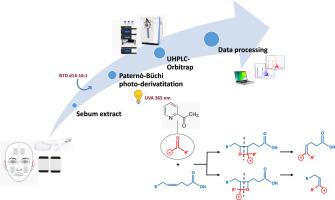人皮脂游离脂肪酸中双键位置的表征
IF 3.2
引用次数: 0
摘要
游离脂肪酸(FFAs)是皮肤表面脂质(SSLs)的重要组成部分,它由表皮脂质和皮脂腺脂质混合而成。sls的皮脂成分在富含皮脂腺(SGs)的脂溢性体区域丰富。皮脂FFAs具有独特的特征,包括C14-C18链长、末端分支和Δ6位置的双键。值得注意的是,超过三分之一的皮脂腺脂肪酸含有一个单双键。不受控制的单不饱和脂肪酸(MUFAs)合成可导致皮脂成分的变化,这有助于炎症性皮肤疾病的发病机制,如寻常性痤疮、酒渣鼻、牛皮癣和脂溢性皮炎。通过碳-碳双键的位置来区分未结合MUFAs的不同异构体的综合表征尚未在人类皮脂中实现。因此,我们旨在开发一种分析策略来区分FFAs中不同的碳-碳双键位置。我们的方法结合了Paternò-Büchi反应,利用2-acpy,液相色谱和串联质谱(LC-MS/MS)。该策略最初在标准FFAs上进行了优化,随后应用于人体皮脂。该方法表征了17个C14-C18链长的MUFAs和2个C18多不饱和FAs,即亚油酸和脂酸。在MUFAs中普遍存在的皂苷酸(C16:1n-10)支持了由FADS2酶催化的Δ6去饱和途径在人SG中占主导地位。此外,该分析证明了男性和女性皮脂中MUFAs和PUFAs的丰度相当。本文章由计算机程序翻译,如有差异,请以英文原文为准。

Characterization of double bond position in free fatty acids of human sebum
Free fatty acids (FFAs) are essential components of skin surface lipids (SSLs), which consist of a blend of epidermal and sebaceous lipids. The sebum component of SSLs is abundant in seborrheic body areas, which are rich in sebaceous glands (SGs). Sebum FFAs exhibit unique characteristics, including a prevalence of C14-C18 chain lengths, terminal branching, and a double bond at the Δ6 position. Notably, over one-third of the sebaceous FAs contain a single double bond. Deregulated synthesis of monounsaturated FAs (MUFAs) can lead to changes in sebum composition, which contribute to the pathogenesis of inflammatory skin conditions such as acne vulgaris, rosacea, psoriasis, and seborrheic dermatitis. A comprehensive characterization of the different isomers of unbound MUFAs distinguished by the position of the carbon-carbon double bond, has not been achieved in human sebum. Therefore, we aimed to develop an analytical strategy to differentiate the various carbon-carbon double bond positions in FFAs. Our methodology combines the Paternò-Büchi reaction, utilizing 2-acpy, with liquid chromatography and tandem mass spectrometry (LC-MS/MS). This strategy was initially optimized on standard FFAs and subsequently applied to human sebum. The method enabled the characterization of seventeen MUFAs with C14-C18 chain lengths and two C18 polyunsaturated FAs, namely linoleic and sebaleic acid. The prevalence of sapienic acid (C16:1n-10) among MUFAs supports the dominance of the Δ6 desaturation pathway catalyzed by the FADS2 enzyme in human SG. Additionally, the assay proved comparable abundance of MUFAs and PUFAs in sebum from males and females.
求助全文
通过发布文献求助,成功后即可免费获取论文全文。
去求助
来源期刊

Journal of chromatography open
Analytical Chemistry
CiteScore
2.50
自引率
0.00%
发文量
0
审稿时长
50 days
 求助内容:
求助内容: 应助结果提醒方式:
应助结果提醒方式:


